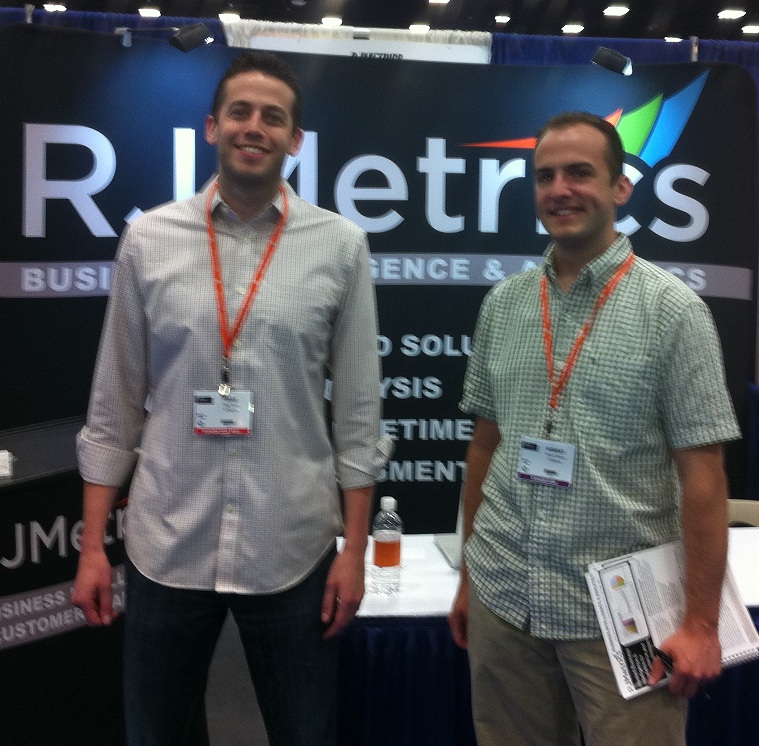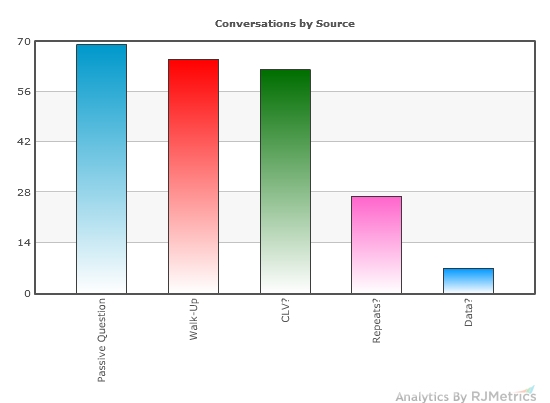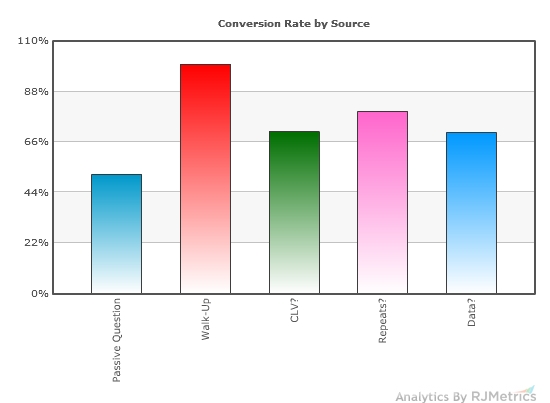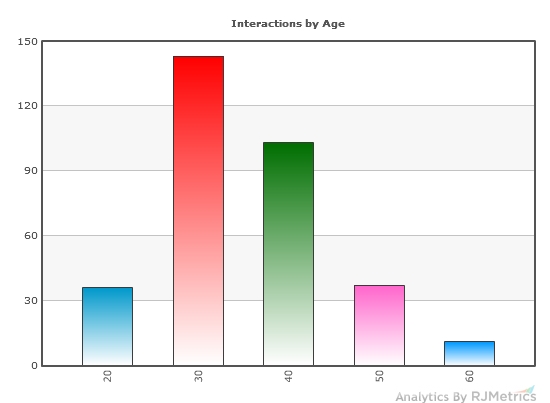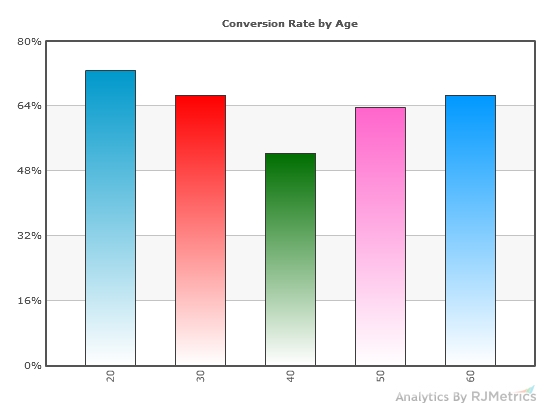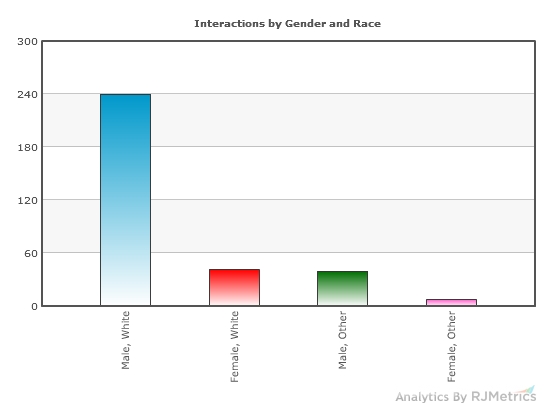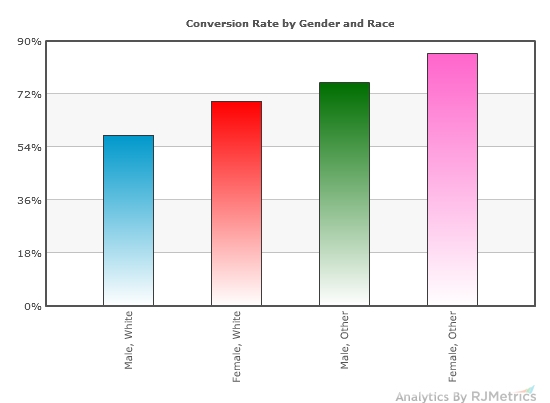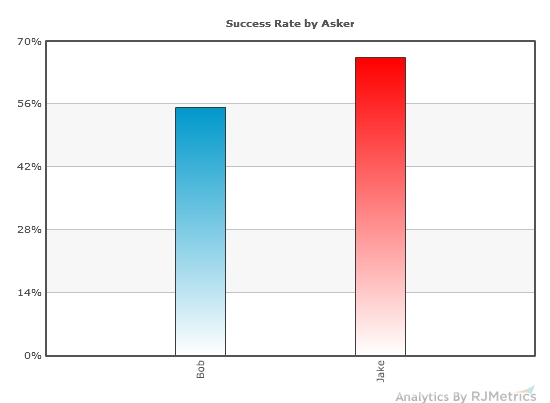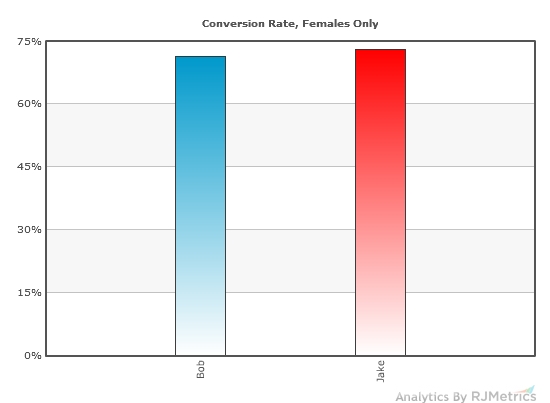Last week, Jake and I attended the 2011 Internet Retailer Conference and Exhibition (IRCE 2011) in San Diego.This four-day event is the world’s largest e-commerce convention, with over 7,200 attendees and 500 exhibiting vendors.
This was our first “real” trade show with RJMetrics and it was a new experience for both of us. Our main objectives were to generate sales leads and raise awareness of RJMetrics in the internet retail community. To help achieve these goals, we purchased a 10’x10’ booth in the exhibit hall to peddle our wares.
This post is a summary of our experience as newbies to the trade show circuit. It is the result of data collection and note-taking on both our and other exhibitors’ behavior and performance. The data taught us three main lessons:
- It pays to be aggressive
- We have the most success with conference attendees who don’t look like us.
- One of us has a very bright future as a carnival barker.
Who wouldn’t buy software from these handsome, slightly blurry gentlemen?
Exhibitor Social Dynamics
Within the first hour of the show, we observed quite a bit. Most notable was that trade show exhibitors appear to all fall somewhere on the “aggression spectrum,” with the most prominent approaches including:
- Disengaged: exhibitors sitting behind their booths, not making eye contact with anyone, and waiting for attendees to approach them.
- Passive: exhibitors standing, saying hello, or otherwise giving physical signs that they are available to speak if passers-by are interested.
- Passive-Question: exhibitors attempting to engage passers-by with easy-to-reject questions such as “Can I give you some information on our company?”
- Aggressive: exhibitors approaching passers-by with out-of-the-blue questions related to their pitch, such as “do you ship product?” or “who is your domain name registrar?”
Additionally, many exhibitors made use of “enhancers” to help attract attendee interest. (We had none of these to offer.) The most popular ones included:
- Swag: Pens! Stress balls! T-Shirts! Nothing softens a sales pitch like free junk with your company’s logo on it. While some attendees were lugging bags of this stuff around, we didn’t perceive any disadvantage by not offering it. (This is based on casual observations of our performance relative to nearby booths that were aggressively distributing swag.)
- Sweepstakes: There was a huge promotion at the conference in which attendees who collected “stickers” from about 40 specific booths would be entered to win a new car. (We could have been one of the 40 booths by shelling out $7,600 to the conference organizers.) We were definitely losing leads to this promotion, as many passers-by used “I have to get my stickers” as a reason for not staying to learn more about us.
- Hot Girls: The vast majority of attendees were male, and some exhibitors hired models to engage passers-by and lure them in for a conversation. This appeared to be effective. However, I can see how certain attendees might find this patronizing or otherwise offensive.
Data Collection
For that first hour, Jake and I waited for people to come to us. We quickly decided that it would be worth A/B testing other approaches to see how we would do. For the next three days, we recorded the following data points about every interaction we had:
- Date and Time
- Badge Type (attendee or exhibitor)
- Gender
- Approximate Age (by decade)
- Ethnicity
- Number of People in Group (when applicable)
- Discussion Starter (Jake or Bob)
- Success or Failure (success was defined as being able to give a 30-second pitch on what we do and learn where the attendee worked and what their role was at the company)
- Approach Used (see below)
- We collected data on four different conversation-starting approaches:
- “What is your average customer lifetime value?” This heavy question was designed to stop people in their tracks and be a lead-in to a conversation about the benefits we provide.
- “How much of your revenue is from repeat customers?” This was a less intimidating question with the same intention as above.
- “Does Your Company Generate Data?” This was a question that we knew people should always say “yes” to.
- “Can I give you some information on RJMetrics?” This was passive-question approach.
- The Walk-Up (when people came up to us unsolicited).
At the end of the three days, we collected 330 data points, 230 of which were successful conversations and exactly 100 of which were rejections.
Inbound vs. Outbound
One thing was clear: it pays to have an outbound strategy. Only 28% of our conversations were walk-ups. This means that employing an outbound strategy allowed us to extract between 3 and 4 times as much value from the show as we would have otherwise.
We initially speculated that the quality of walk-up traffic would be higher than that of random passers-by. However, we observed (unscientifically) that this was not the case. While some very high-value prospects did approach us as walk-ups, we ultimately derived more qualified leads from our outbound conversations.
Effectiveness by Outbound Approach
Naturally, 100% of walk-ups converted into conversations. Below, we show the conversion rates on the other outbound approaches.
Clearly, the more aggressive methods (i.e. asking a pointed question that is difficult to brush off) were the most effective. Asking questions about repeat purchase rates such as “What Percent of Your Customers Come Back to Purchase a Second Time?” was the most effective method, with a whopping 79% conversion rate.
The least effective method of the outbound approaches was the passive-question technique (i.e. “Can I give you some information on RJMetrics?”)
Age
The most common passer-by was in their 30s, and the populations steadily dropped off with each additional decade of age. The percentage of attendees in their 20s (like us) was surprisingly small.
Our success rates were lowest with attendees in their 40s, but increased substantially at each extreme end of the age spectrum. We weren’t surpised by our success with 20-somethings, but would not have predicted that we’d have such strong performance with much older attendees.
Race and Gender
We were interested in the breakdown of attendees at the conference and our relative success levels with different groups of people. While there is a potential for selection bias here, we feel that we spoke with a random sample of the conference population. As such, the breakdown of our interactions is likely representative of the conference population as a whole.
72% of our interactions were with white males. Interestingly, it was about as likely that we interacted with someone who was non-white (15%) as with someone who was non-male (13%).
The conversion rates of different race and gender combinations are also quite interesting. We were least likely to convert white males (58%) and most likely to convert non-white females (87%). Overall, our conversion rates on females and non-white attendees were higher than their counterparts.
Jake vs. Bob
So, who was the better pitchman? Despite heroic trash talking, Jake put me to shame. 66% of his attempts converted into conversations (compared to my paltry 55%).
We also looked at conversion attempts for females only. This data revealed that, while Jake still converted attempts into conversations at a higher rate than I did, the gap was significantly smaller. Unfortunately, these rates did not carry over to the after parties.
The ROI of An Aggressive Pitch
All-in, our booth space, display materials, meals, travel, and accommodations added up to about $8,000 of total expense. (This does not include the opportunity cost of our time.)
The exhibit hall was open for a total of 20.5 hours across 3 days, which works out to about $6.50 per minute to participate in the exhibition. As the co-founders of a bootstrapped company, that figure weighed heavily in our minds every time we considered getting some lunch or taking a bathroom break.
If you look at our total interactions, the numbers get even larger. Based on our count of 220 conversations, we paid around $36 per pitch. This is where our aggressive sales strategy really makes a significant impact. If we had only interacted with the 65 walk-ups from the conference, that effective rate would have been $123 per pitch.
In other words, we extracted nearly 3 times as much value from our conference experience by simply getting out in front of the booth and selling more aggressively.
Given these data points, it becomes clear why some companies are willing to invest money in novelties and gimmicks to increase traffic to their booths. Spending a few thousand dollars could double or triple the effectiveness of your experience while increasing your costs by a significantly smaller percentage.
Was it Worth It?
Given the price point of our product, we will break even on this conference if we convert a single lead into a long-term customer. Based on the leads generated and our typical sales cycle, it seems very likely that we will do much better than that.
There were also less tangible benefits to participating in the show. We increased brand awareness, strengthening our relationships with existing customers, scoping out the competition, and keeping up-to-date with emerging trends and technologies.
Perhaps most importantly, however, this experience has given us a new perspective on how to think about the costs of customer acquisition and spending money to acquire new business. If this show turns out to be a profitable endeavor, we will have have a great baseline for the cost of putting people into the top of our sales funnel. With this data, we can feel much more confident about making investments in advertising and other forms of lead generation.

